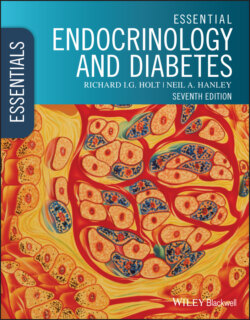Читать книгу Essential Endocrinology and Diabetes - Richard I. G. Holt - Страница 77
Orphan nuclear receptors and variant nuclear receptors
ОглавлениеSome orphan and variant receptors play essential roles in endocrinology. For instance, steroidogenic factor 1 (SF1, also called NR5A1) is a critical mediator of endocrine organ formation. Without it, the anterior pituitary gonadotrophs, adrenal gland and gonad fail to develop. It is also critical for the ongoing expression of many important genes within these cell types (e.g. the enzymes that orchestrate steroidogenesis; Figure 2.6). A variant receptor with a similar expression profile is DAX1 (also called NROB1), mutation of which causes X‐linked congenital adrenal hypoplasia (i.e. under‐development). Duplication of the region that includes the gene encoding DAX1 causes male‐to‐female sex reversal (Chapters 6 and 7). Increasingly, endogenous compounds are being identified that occupy the three‐dimensional structure created by the ligand‐binding domain. Whether these substances are the true hormone ligands remains debatable.
Figure 3.16 Hormonal stimulation of intracellular phospholipid turnover and calcium metabolism. Phosphatidylinositol (PI) metabolism includes the membrane intermediaries, PI monophosphate (PIP) and PI bisphosphate (PIP2). Hormone action stimulates phospholipase C, which hydrolyzes PIP2 to diacylglycerol (DAG) and inositol triphosphate (IP3). IP3 mobilizes calcium, particularly from the endoplasmic reticulum. DAG activates protein kinase C and increases its affinity for calcium ions, which further enhances activation. Collectively, these events stimulate phosphorylation cascades of proteins and enzymes that alter intracellular metabolism.
Figure 3.17 Eicosanoid signalling. Arachidonic acid, released by phospholipase A2, is the rate‐limiting precursor for generating eicosanoid signalling molecules by cyclo‐oxygenase (COX) and lipoxygenase pathways. This example produces prostaglandin E2 (PGE2), but there are at least 16 prostaglandins, all structurally related, 20‐carbon, fatty acid derivatives. They are released from many cell‐types and exert paracrine and autocrine actions (e.g. the inflammatory response and contraction of uterine smooth muscle). Their circulating half‐life is short (3–10 min). Aspirin inhibits prostaglandin production at sites of inflammation. There are different forms of COX; until withdrawn due to side‐effects, inhibitors of COX‐2 were used as anti‐inflammatory agents.
Figure 3.18 Simplified schematic of nuclear hormone action. (a) Free hormone (a steroid is shown), in equilibrium with protein‐bound hormone, diffuses across the target cell membrane. (b) Inside the cell, free hormone binds to its receptor (). This may occur in the cell cytoplasm (e.g. glucocorticoid receptor) or in the cell nucleus (e.g. thyroid hormone receptor). (c) The activated hormone–receptor complex (*), now present in the nucleus, binds to the hormone‐response element of its target genes. (d) This interaction promotes DNA‐dependent RNA polymerase (Pol II) to start transcription of mRNA. (e) Post‐transcriptional modification and splicing sees the mRNA exit the nucleus for translation into protein on ribosomes. Post‐translational modification provides the final protein.
